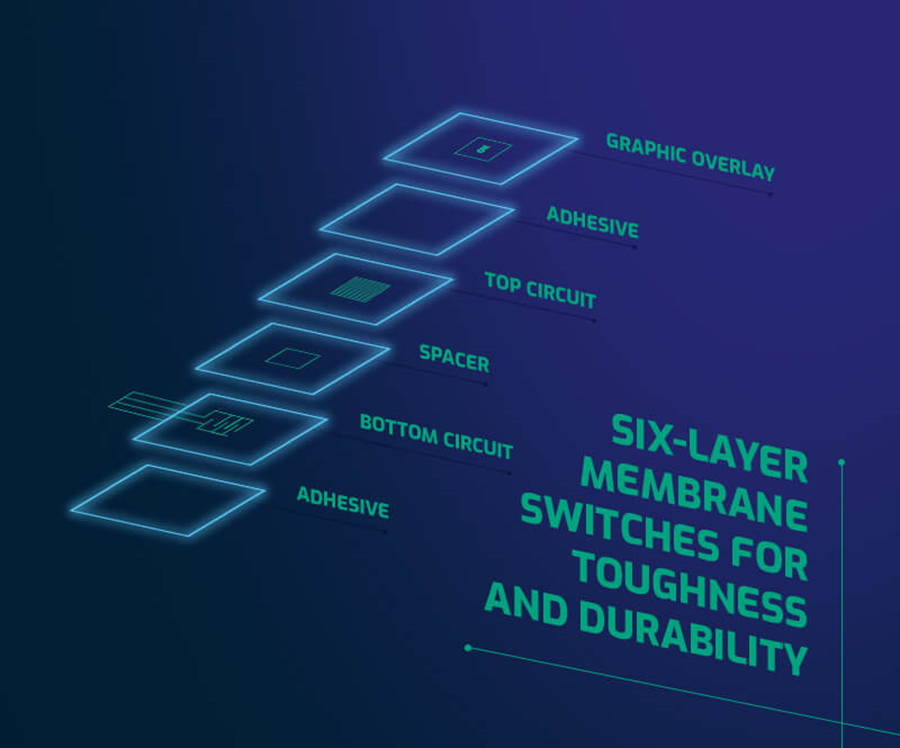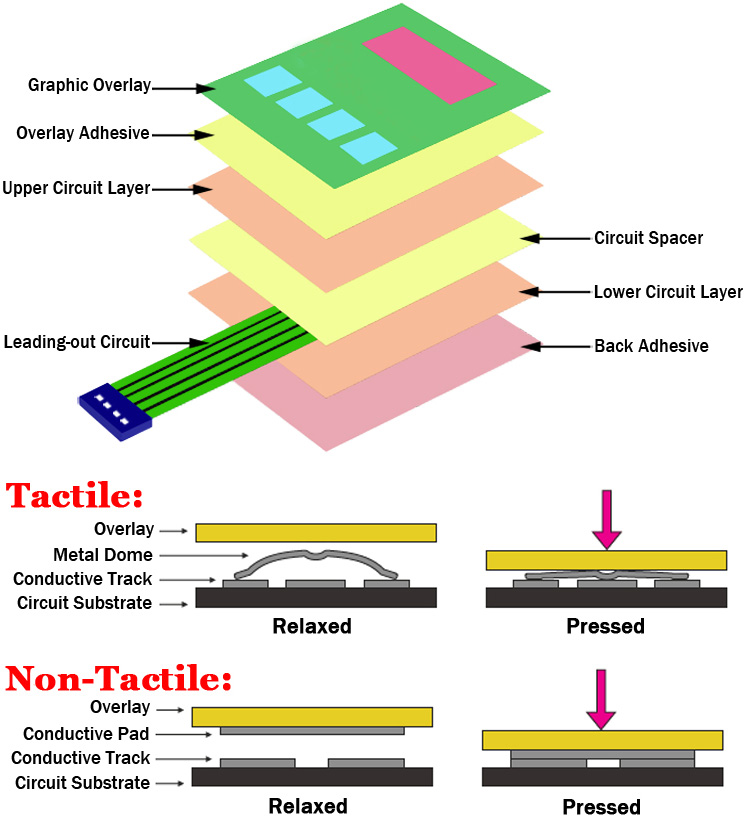All Concerning Membrane layer Change: A Comprehensive Overview for Beginners
Membrane buttons are vital elements in contemporary electronics, using a special interface for customer interaction - membrane switch. Their split building and construction, including overlays and conductive traces, provides performance and toughness. Unlike conventional mechanical buttons, membrane buttons provide a sleek design and adjustable options. Understanding their vital attributes and advantages can change item style. However, the ins and outs of their application and layout factors to consider warrant further exploration
What Is a Membrane layer Change?
A membrane switch is a kind of electrical button that includes a versatile membrane layer layered over a published motherboard. This style permits a streamlined and portable user interface, typically utilized in different digital gadgets. Membrane layer buttons are typically found in consumer devices, medical equipment, and industrial machinery due to their toughness and resistance to environmental factors.The construction commonly includes multiple layers, such as graphic overlays and adhesive support, which offer responsive comments and protect the circuitry underneath. The procedure of a membrane layer button is launched when pressure is put on the surface area, finishing an electric circuit.These switches are valued for their versatility, enabling customized styles and published graphics that accommodate specific interface. Their inconspicuous nature reduces space needs, making them suitable for applications where traditional buttons may not fit. Generally, membrane buttons supply a aesthetic and practical solution for modern-day electronic devices.
Secret Components of Membrane Changes
Membrane switches over consist of several essential parts that add to their capability and efficiency. The leading layer, understood as the overlay, supplies the interface and is typically published with signs or graphics. Under the overlay exists a spacer layer, which divides the conductive aspects and avoids unintentional activation. The next important part is the graphic layer, which enhances looks and assures the toughness of the design.Conductive traces, usually made from products like silver or carbon, are published on the circuit layer. When stress is applied to the overlay, these traces enter into contact, completing the circuit. Furthermore, a backing layer offers architectural support and can be made from products such as polyester or polycarbonate. Together, these parts develop a reliable, easy to use user interface suitable for different applications, from home devices to commercial tools. Recognizing these elements is crucial for any individual interested in membrane layer switch technology.
Exactly How Membrane Switches Over Work
Comprehending how membrane switches over function is essential for valuing their widespread use in numerous gadgets. A membrane switch runs with a series of layers, including a graphic overlay, spacer, and a circuit layer. When stress is put on the overlay, it presses the spacer layer, allowing the circuit layer to make contact and finish an electric circuit. This activity sends a signal to the gadget, triggering a feedback, such as switching on a light or turning on a function.Membrane changes can be created with various functions, consisting of responsive responses, backlighting, and custom-made graphics, improving individual interaction. Their building and construction enables a closed design, securing the interior components from dust, wetness, and contaminants. This toughness makes them suitable for diverse applications, from customer electronic devices to commercial tools. On the whole, the simplicity and efficiency of membrane switches over add to their popularity in modern innovation.
Advantages of Membrane Switches Mechanical Switches
While mechanical switches have long been a staple in many tools, membrane layer switches over deal distinct benefits that make them significantly appealing. One substantial advantage is their slim account, allowing for more portable designs and higher versatility in product development. Additionally, membrane layer changes feature an uniform surface, which boosts aesthetic charm and simplifies cleansing, making them ideal for atmospheres where health is critical.Another advantage is their resistance to dust and dampness. Unlike mechanical switches, which can be jeopardized by environmental factors, membrane buttons supply a closed interface that shields against contaminants - membrane switch. Membrane layer switches generally have a longer life-span due to fewer moving components, resulting in boosted durability and reliability.Cost-effectiveness is likewise a noteworthy benefit, as membrane layer buttons can be produced in bulk with reduced manufacturing expenses. These aspects integrate to place membrane switches as a useful choice to traditional mechanical alternatives in numerous applications
Common Applications of Membrane Layer Switches
Membrane switches are widely made use of in different fields, especially in consumer electronic devices and industrial control panels. In customer tools, they offer a smooth, easy to use user interface, while in commercial setups, they improve longevity and performance. Comprehending these applications highlights the adaptability and functionality of membrane switches in modern-day technology.
Consumer Electronics Devices
As consumer electronic devices remain to evolve, membrane switches have actually become a prominent choice for a selection of tools due to their versatility and smooth design. These buttons are commonly located in mobile phones, tablets, and remote controls, where area is minimal and aesthetics issue. Their low profile and personalized designs permit manufacturers to create easy to use user interfaces that enhance the total customer experience. In addition, membrane switches are commonly made use of in appliances such as microwaves and coffee machine, offering instinctive control choices while resisting wetness and dust. The toughness and reliability of membrane layer switches over make them suitable for day-to-day consumer products, making sure longevity and consistent efficiency. Overall, their combination in consumer electronic devices shows a blend of functionality and contemporary style.
Industrial Control Panels
The applications of membrane layer switches extend beyond consumer electronic devices, finding significant usage in industrial control panels. These switches are preferred for their sturdiness and resistance to rough environments, making them perfect for manufacturing and procedure control setups. They supply a reliable interface for operators to manage equipment, screen procedures, and readjust settings. Membrane switches can be personalized to suit details operational demands, integrating attributes like backlighting and tactile responses, enhancing customer experience. Their inconspicuous style permits combination right into numerous equipment, while their capacity to stand up to spills, dirt, and severe temperature levels warranties longevity. In general, membrane switches add to secure and efficient procedure in commercial applications, demonstrating their flexibility and efficiency popular environments.
Considerations for Creating Membrane Switches Over
When designing membrane buttons, look what i found choosing the best materials is necessary to guarantee sturdiness and functionality. Additionally, understanding layer setup techniques can greatly affect the button's efficiency and individual experience. These considerations play a vital function in developing efficient and trustworthy membrane button styles.
Product Choice Value
Product choice plays a vital role in the style and functionality of membrane layer buttons. The selected products directly affect the switch's sturdiness, responsive response, and overall visual. Secret factors to consider include the substratum, which must supply structural honesty while enabling flexibility, and the graphic overlay, which needs to be resistant to use and ecological variables. Conductive products need to guarantee reputable electric efficiency, while adhesives have to use solid bonding without compromising the switch's operation. In addition, compatibility with manufacturing procedures and end-user environments is vital; products have to endure varying temperatures, moisture degrees, and chemical exposure. Eventually, suitable product option not just boosts the membrane layer button's performance yet additionally adds to its longevity and customer contentment, making it a crucial facet of the design procedure.

Layer Configuration Techniques

Frequently Asked Inquiries
For How Long Do Membrane Switches Commonly Last?
Membrane buttons usually have a life expectancy of 1 to 5 million cycles, relying on use and ecological conditions. Variables such as style high quality and operating frequency significantly influence their sturdiness and overall efficiency longevity.

Can Membrane Switches Over Be Custom-made for Specific Styles?
Membrane switches can certainly be personalized to suit certain layouts, permitting diverse forms, shades, and performances. This convenience allows manufacturers to tailor these buttons to fulfill one-of-a-kind visual and operational requirements efficiently.
What Products Are Made Use Of in Membrane Switch Building?
Membrane buttons are commonly created making use of materials such as polyester, polycarbonate, and glue layers. These products give resistance, resilience, and adaptability to ecological elements, ensuring the switches function efficiently in various applications and problems.
Are Membrane Switches Immune or water resistant to Moisture?
Membrane switches can be made to be moisture-resistant, utilizing specialized coverings and products. However, their water home resistant abilities depend upon construction top quality and particular applications, making it important to analyze needs for excellent performance in different environments.
Just How Are Membrane Layer Switches Repaired if Damaged?
Repairing broken membrane switches typically involves changing the influenced layer or circuit. Service technicians might additionally use conductive adhesive or utilize specialized repair packages, guaranteeing performance is brought back without complete replacement of the entire button assembly. Unlike conventional mechanical switches, membrane layer switches offer a sleek style and personalized choices. A membrane switch is a type of electrical switch that is composed of a flexible membrane layer layered over a printed circuit board. The operation of a membrane button is started when pressure is used to the surface area, finishing an electrical circuit.These buttons are valued for their versatility, making it possible for customized layouts and published graphics that cater to specific user interfaces. While mechanical buttons have actually long been a staple in several gadgets, membrane layer switches over offer distinctive benefits that make them significantly appealing. Membrane layer buttons generally have a longer life-span due to fewer relocating components, resulting in enhanced longevity and reliability.Cost-effectiveness is likewise a noteworthy advantage, as membrane buttons can be generated in mass with reduced manufacturing costs.
Comments on “Why membrane switch is helping streamline industrial workflows”